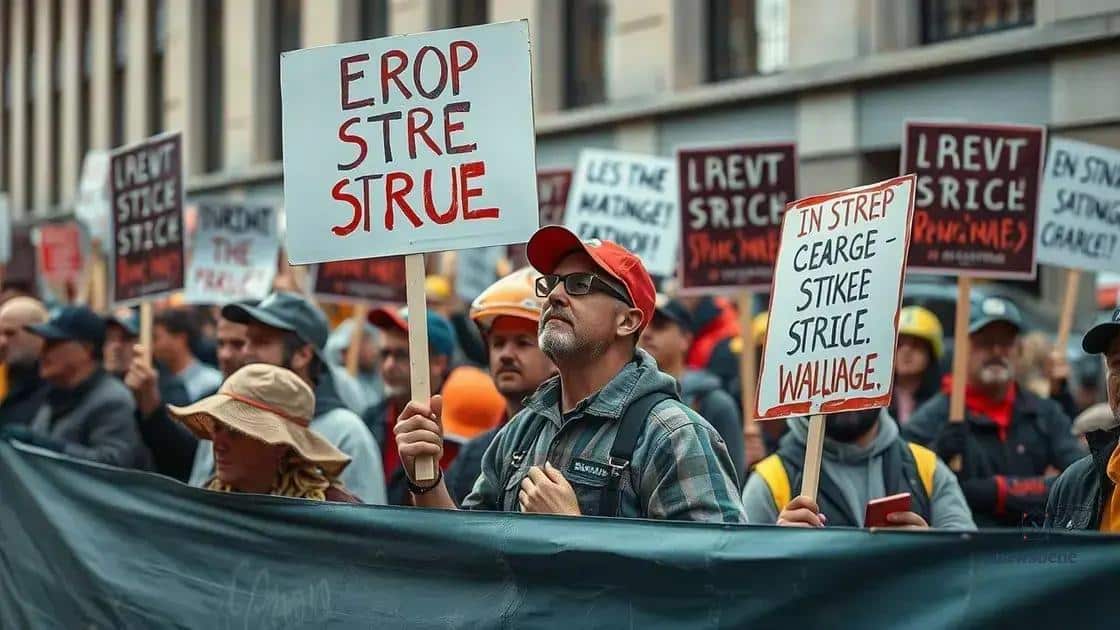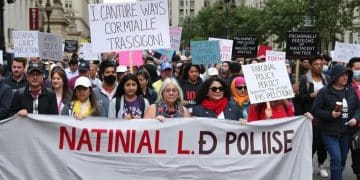Labor union-organized strike actions reshaping the workplace

Labor union-organized strike actions are collective efforts by workers to demand better wages, safe working conditions, and job security, significantly impacting industries and prompting changes in labor rights and activism strategies.
Labor union-organized strike actions are becoming increasingly vital in today’s workforce. Have you noticed how these movements shape workplaces and influence policies? Let’s delve into their growing significance.
What are labor union-organized strike actions?
Labor union-organized strike actions are collective efforts where workers come together to halt work. This usually occurs when they seek to negotiate better conditions, pay, or benefits from their employers. It’s a powerful tool for workers to voice their concerns and push for change.
These strikes often arise from unresolved disputes between workers and employers. When dialogue fails, unions may decide that a strike is necessary. This can lead to significant impact not only on the company involved but also on the economy.
Key Characteristics of Strike Actions
Labor union-organized strike actions share some common characteristics:
- Collective effort involving a significant number of workers.
- Organized by labor unions representing the employees.
- Focused on specific demands, such as wage increases or safer working conditions.
When a strike is called, it sends a strong message. It shows employers that employees are serious about their demands. Strikes can often gain public attention, leading to broader support for workers’ rights. The media frequently covers these events, highlighting the reasons behind the strike.
Types of Strike Actions
There are different types of strike actions that can occur:
- General strikes: Involves workers from various sectors ceasing work.
- Sympathy strikes: Support for workers on strike by other workers.
- Wildcat strikes: Actions taken without union approval.
Understanding the implications of these actions is crucial. They not only affect the workers involved but also have ripple effects across industries and communities. For many, these strikes represent a last resort in their quest for fairness. The outcomes can lead to improved conditions for workers, influencing labor practices for years to come.
Historical context of labor strikes
The historical context of labor strikes is essential to understanding their role in shaping workers’ rights today. Strikes have been part of labor movement history for centuries, reflecting the struggles of workers to achieve fair treatment. From the industrial revolution to the present day, these actions tell a powerful story of resistance and change.
In the late 19th century, labor strikes surged as workers sought better pay and working conditions. These early strikes often faced harsh repression. For example, the Pullman Strike in 1894 was a significant event that led to violent clashes and numerous deaths, highlighting the desperate conditions workers faced.
Key Events in Labor Strike History
Several pivotal moments stand out in the annals of labor strikes:
- The Haymarket Affair of 1886, where a peaceful rally turned deadly, raising awareness about workers’ rights.
- The Homestead Strike of 1892, which involved steelworkers fighting against wage cuts.
- The 1912 Lawrence Textile Strike, where diverse groups united for fair wages.
Each of these events contributed to the public’s perception of labor movements, often stimulating further action and support for workers’ rights initiatives. Over time, governments began to recognize the importance of these movements.
Labor Legislation and Its Impact
As labor strikes grew more common, legislation was gradually established to protect workers. Laws like the Wagner Act of 1935 strengthened workers’ rights to organize and strike. This act played a crucial role in empowering labor unions and enhancing workers’ bargaining power.
Throughout the 20th century, labor strikes continued to evolve. The rise of automation and globalization introduced new challenges for workers. Today, ongoing strikes address modern issues, such as fair wages and job security, showing that the fight for workers’ rights is far from over.
Key issues driving recent strike actions

Recent labor strikes have been influenced by several key issues that reflect the changing landscape of work. As workers continue to advocate for their rights, understanding these driving factors is essential. Among the most significant issues are low wages, unsafe working conditions, and job security.
Many workers feel that their labor does not equate to fair compensation. In various industries, wages have not kept pace with inflation. This has led to increased demands for higher pay, especially in sectors like retail and hospitality, where employees often face economic hardships.
Unsafe Working Conditions
Another critical concern is unsafe working conditions. Many employees report that their work environments jeopardize their health and safety. This is particularly evident in construction, manufacturing, and healthcare sectors, where risks can be significant. Strikes often occur when workers are unsatisfied with how their employers address these safety issues.
- Lack of proper safety equipment.
- Insufficient training for handling hazardous materials.
- High rates of workplace injuries and accidents.
Furthermore, job security has become a pressing issue for many. The rise of automation and outsourcing has created uncertainty for workers. Many fear losing their jobs to machines or to cheaper labor markets abroad. This insecurity drives workers to strike in hopes of protecting their positions and negotiating better terms.
Work-Life Balance and Benefits
Lastly, the demand for better work-life balance and benefits has fueled recent movements. Employees seek flexibility in their schedules and improved benefits, such as health insurance and paid leave. These factors are becoming increasingly critical as workers prioritize their well-being alongside their job responsibilities.
By addressing these key issues, unions and workers stand a better chance of negotiating meaningful changes. As the labor landscape evolves, understanding these factors becomes vital to comprehending the reasons behind the ongoing wave of strikes.
Impact of strikes on industries and workers
The impact of strikes on industries and workers can be profound and far-reaching. When workers strike, they aim to bring attention to their demands and create pressure for change. This not only affects the workers involved but also the industries in which they operate.
For businesses, strikes can lead to significant disruptions. When employees halt work, production slows or stops entirely. This can affect supply chains, reducing the ability of companies to meet customer demands. Additionally, prolonged strikes may lead to financial losses due to missed deadlines and reduced revenue.
Economic Consequences
Strikes also have economic consequences that can ripple through local economies. Businesses that rely on the affected industries may face challenges. For example, suppliers that provide raw materials may see a decrease in orders. Local retailers that depend on high foot traffic from workers may also suffer.
- Loss of income for workers during strikes.
- Increased costs for businesses due to lost productivity.
- Potential layoffs if strikes lead to long-term financial instability.
On the other hand, strikes can lead to positive changes for workers. Successful actions can result in better wages, improved safety conditions, and enhanced job security. These victories not only benefit the employees directly involved but can also set standards for other workers across the industry.
Shifts in Public Perception
Strikes can influence public perception of industries and labor rights. When workers stand together, they can garner the support of the community. Media coverage can help bring attention to their struggles, often shifting public opinion in favor of the workers. This support can lead to broader movements advocating for labor rights.
Ultimately, the impact of strikes extends beyond immediate outcomes. They serve as powerful reminders of the ongoing struggles for fairness and equity in the workplace. Strikes not only highlight the needs of workers but also often prompt changes in policies and practices within industries.
Future trends in labor union activism
The future trends in labor union activism reveal a dynamic landscape influenced by technology, shifting workforce demographics, and evolving economic conditions. As workers face new challenges, unions are adapting their strategies to remain relevant and effective.
One significant trend is the increased use of technology in organizing efforts. Social media platforms have become essential tools for unions. They allow for rapid communication and mobilization of workers. With the ability to share information quickly, unions can reach a broader audience and gain support for their causes.
Emphasis on Inclusivity
Another important trend is the emphasis on inclusivity within labor unions. Today’s workforce is more diverse than ever, with various backgrounds and experiences represented. Unions are recognizing the importance of addressing the needs of all workers, especially those from historically underrepresented groups. This focus on inclusion fosters solidarity and strengthens the labor movement.
- Efforts to engage younger workers who prioritize different values.
- Programs aimed at improving conditions for gig and freelance workers.
- Campaigns focused on racial and gender equality within the workforce.
Additionally, the rise of the gig economy poses unique challenges for labor unions. Many gig workers lack traditional employment benefits and protections. Unions are exploring innovative ways to support these workers, advocating for fair wages and safe working conditions.
Environmental Justice and Labor
Environmental justice is becoming another vital issue intertwined with labor activism. Unions are increasingly acknowledging the impact of environmental policies on workers. By advocating for green jobs and sustainable practices, they aim to create safe work environments while addressing climate change.
As the landscape of labor activism evolves, unions must remain adaptable. The future will likely see further collaboration across industries and movements. Unions may join forces with social justice organizations to tackle broader societal issues. This approach can amplify their message and bring about more significant changes.
FAQ – Frequently Asked Questions About Labor Union Activism
What are the main reasons for recent labor strikes?
Recent labor strikes are mainly driven by low wages, unsafe working conditions, and job security concerns.
How has technology changed labor union activism?
Technology, especially social media, allows unions to organize more effectively and communicate rapidly with workers.
Why is inclusivity important in labor unions?
Inclusivity ensures that all workers, especially those from diverse backgrounds, have their voices heard and needs addressed.
What role does environmental justice play in labor movements?
Environmental justice is becoming integral as unions advocate for sustainable practices that protect both workers and the planet.






